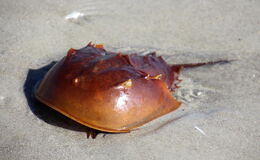
If you want to see one of the world’s oldest natural phenomena, then make a journey to the Delaware Bay in late spring. During full and new moons and high tides in May and June, hundreds of thousands of horseshoe crabs converge on the Delaware Bay to breed. This might not seem amazing at first, but consider that horseshoe crabs have been around for over 300 million years. That’s older than the dinosaurs! Along with seeing horseshoe crabs breed, a visit to the Delaware Bay provides one of the finest opportunities to wildlife watch. Many shorebirds, migratory birds, turtles and fish use horseshoe crab eggs as an important part of their diet. Horseshoe crabs are a keystone species within the Delaware Bay ecosystem.
Description[]
Horseshoe crabs look like prehistoric crabs. They have a hard exoskeleton, ten walking legs under the shell, spines on the abdomen and a long tail. The body of the horseshoe crab is divided into three sections. The first section is the head (also called the prosoma). It is the largest part of the body with much of the nervous and biological organs. The head has the brain, heart, mouth, nervous system and glands protected by a large plate.
The head also protects the largest set of eyes. Horseshoe crabs have nine eyes scattered throughout the body and several more light receptors near the tail. The two largest eyes are compound and useful for finding mates. The other eyes and light receptors are useful for determining movement and changes in moonlight. The middle section of the body is called the abdomen (also known as the opisthosoma). It looks like a triangle with spines on the sides and a ridge in the center. The spines are moveable and help protect the horseshoe crab. On the underside of the abdomen are the muscles for movement and the gills for breathing.
A horseshoe crab’s tail is called the telson. It is long and pointed. Although the telson looks intimidating, it is not dangerous, poisonous or used to sting. Horseshoe crabs use the telson to flip over if they happen to be pushed on their backs. It's harmless! The name “horseshoe crab” originates from the rounded shape of the head. Just like the shoe on a horse’s foot, the head is rounded and U-shaped. Although horseshoe crabs look similar to crabs and lobsters, they are actually more closely related to scorpions and spiders.
Size: Horseshoe crab females are about 1/3 larger than the males. They can be about 18-19 inches from head to tail, while the males are approximately 14-15 inches.
Diet: Horseshoe crabs like to dine on worms and clams.
Typical Lifespan: Horseshoe crabs reach sexual maturity at around 10 years of age. They can live to over 20 years of age.
Habitat: Horseshoe crabs utilize different habitat depending on the stage in their development. The eggs are laid on coastal beaches in late spring and summer. After hatching, the juvenile horseshoe crabs can be found offshore on the sandy ocean floor of tidal flats. Adult horseshoe crabs feed deeper in the ocean until they return to the beach to spawn.
Range: Limulus polyphemus is found in the Atlantic Ocean along the North American coastline. They can be seen along the East and Gulf coasts of the United States and Mexico. There are three other species of horseshoe crab worldwide. The other species are located in the Indian Ocean and in the Pacific Ocean along the coast of Asia.
Communication: Female horseshoe crabs communicate using pheromones (natural chemicals). The female releases pheromones to signal to the males that it is time to mate.
Life History and Reproduction[]
During the late spring and early summer, adult horseshoe crabs travel from deep ocean waters to beaches along the East and Gulf coasts. The males arrive first and await the females for breeding. When the females come to shore, they release pheromones that attract the males. Horseshoe crabs prefer to breed at night during high tides, new and full moons. The males grasp onto the females and together they head to the shoreline. On the beach, the females dig small nests and deposit eggs. The males will fertilize the eggs. The process can be repeated multiple times with tens of thousands of eggs.
Horseshoe crab eggs are a food source for numerous birds, reptiles and fish. Most horseshoe crabs will not even make it to the larval stage before being eaten. If the egg survives, the larval horseshoe crab will hatch from the egg after about 2 weeks or more. The larva looks like a very tiny version of an adult horseshoe crab without a tail. Larval horseshoe crabs travel into the ocean water and settle on the sandy bottom of the tidal flats for a year or more. As they develop, they will move into deeper waters and begin to eat more adult food. Over the next 10 years or so, the juvenile horseshoe crabs will molt and grow. The molting process requires shedding small exoskeletons in exchange for larger shells. Horseshoe crabs go through 16 or 17 molts during development. At around 10 years of age, horseshoe crabs reach adulthood. They are ready to start breeding themselves and will migrate to coastal beaches in spring.